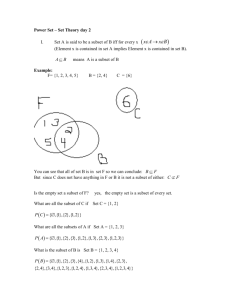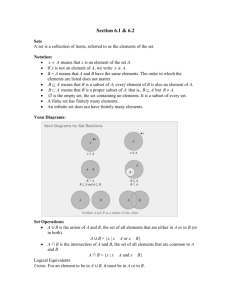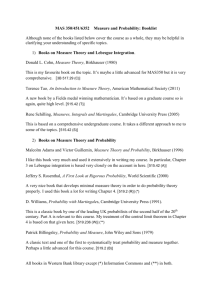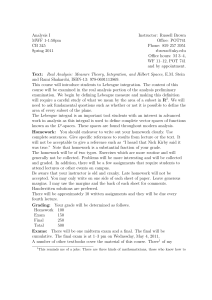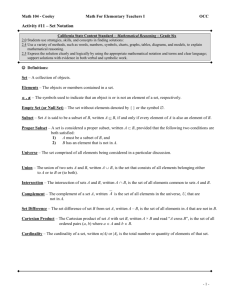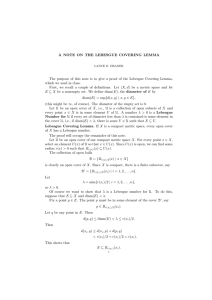SUBSETS OF THE PLANE WITH SMALL LINEAR TWO-DIMENSIONAL LEBESGUE MEASURE
advertisement
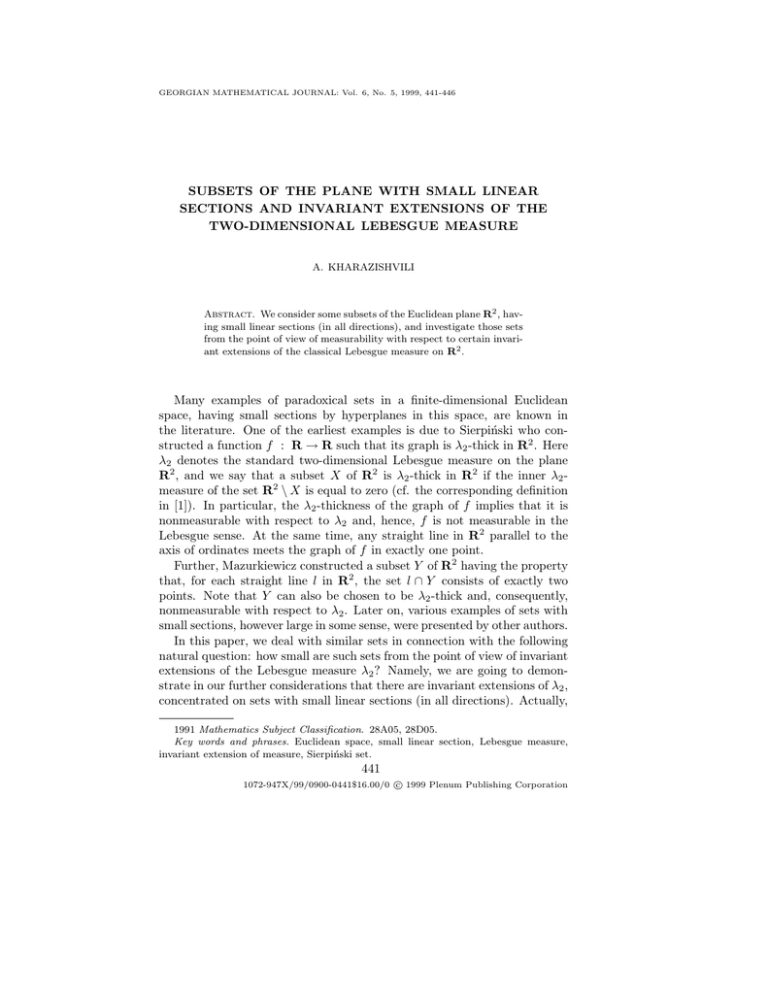
GEORGIAN MATHEMATICAL JOURNAL: Vol. 6, No. 5, 1999, 441-446
SUBSETS OF THE PLANE WITH SMALL LINEAR
SECTIONS AND INVARIANT EXTENSIONS OF THE
TWO-DIMENSIONAL LEBESGUE MEASURE
A. KHARAZISHVILI
Abstract. We consider some subsets of the Euclidean plane R2 , having small linear sections (in all directions), and investigate those sets
from the point of view of measurability with respect to certain invariant extensions of the classical Lebesgue measure on R2 .
Many examples of paradoxical sets in a finite-dimensional Euclidean
space, having small sections by hyperplanes in this space, are known in
the literature. One of the earliest examples is due to Sierpiński who constructed a function f : R → R such that its graph is λ2 -thick in R2 . Here
λ2 denotes the standard two-dimensional Lebesgue measure on the plane
R2 , and we say that a subset X of R2 is λ2 -thick in R2 if the inner λ2 measure of the set R2 \ X is equal to zero (cf. the corresponding definition
in [1]). In particular, the λ2 -thickness of the graph of f implies that it is
nonmeasurable with respect to λ2 and, hence, f is not measurable in the
Lebesgue sense. At the same time, any straight line in R2 parallel to the
axis of ordinates meets the graph of f in exactly one point.
Further, Mazurkiewicz constructed a subset Y of R2 having the property
that, for each straight line l in R2 , the set l ∩ Y consists of exactly two
points. Note that Y can also be chosen to be λ2 -thick and, consequently,
nonmeasurable with respect to λ2 . Later on, various examples of sets with
small sections, however large in some sense, were presented by other authors.
In this paper, we deal with similar sets in connection with the following
natural question: how small are such sets from the point of view of invariant
extensions of the Lebesgue measure λ2 ? Namely, we are going to demonstrate in our further considerations that there are invariant extensions of λ2 ,
concentrated on sets with small linear sections (in all directions). Actually,
1991 Mathematics Subject Classification. 28A05, 28D05.
Key words and phrases. Euclidean space, small linear section, Lebesgue measure,
invariant extension of measure, Sierpiński set.
441
c 1999 Plenum Publishing Corporation
1072-947X/99/0900-0441$16.00/0
442
A. KHARAZISHVILI
a more stronger result will be obtained stating that the corresponding sets
can even have small sections by all analytic curves lying in the plane.
Let λn denote the standard n-dimensional Lebesgue measure on the Euclidean space Rn , where n ≥ 2.
Below, we need the following auxiliary statement which is also rather
useful in many other situations.
Lemma 1. Let Z be a λn -measurable subset of the Euclidean space Rn
with λn (Z) > 0 and let {Mi : i ∈ I} be a family of analytic manifolds in
Rn , such that
(1) card(I) is strictly less than the cardinality continuum;
(2) for each index i ∈ I, the dimension of Mi is strictly less than n.
Then the relation Z \ ∪{Mi : i ∈ I} 6= ∅ is satisfied.
The proof of this lemma is not difficult and can be carried out by induction on n (here the classical Fubini theorem plays an essential role). For
details, see, e.g., [2]. Some applications of the lemma to certain questions
of the geometry of Euclidean spaces may be found in [3]. Note also that the
lemma does not hold true for topological manifolds in Rn . For example,
there are models of set theory in which the Euclidean plane can be covered by a family of Jordan curves, whose cardinality is strictly less than the
cardinality continuum.
Starting with the above-mentioned lemma we are able to establish the
following result.
Theorem 1. Let G be the group of all analytic diffeomorphisms of Rn .
Then there exists a subset X of Rn such that
(1) X is almost G-invariant, i.e.,
(∀g ∈ G)(card(g(X)4X) < c)
where the symbol 4 denotes the operation of symmetric difference of sets
and the symbol c denotes the cardinality continuum;
(2) X is λn -thick in Rn ;
(3) for any analytic manifold M in Rn with dim(M ) < n, we have
card(M ∩ X) < c.
Proof. We use the method developed in [2], [3] and [4]. Let α denote the
least ordinal number of cardinality continuum. Since the equality card(G) =
c holds, we may write
G = ∪{Gξ : ξ < α}
where {Gξ : ξ < α} is some α-sequence of subgroups of G, satisfying these
two conditions:
SUBSETS OF THE PLANE WITH SMALL LINEAR SECTIONS
443
(a) for each ordinal ξ < α, we have the inequality
card(Gξ ) ≤ card(ξ) + ω,
where ω denotes the first infinite cardinal;
(b) the family {Gξ : ξ < α} is increasing by inclusion.
Also, we may consider the family {Yξ : ξ < α} consisting of all Borel
subsets of Rn with a strictly positive n-dimensional Lebesgue measure. Finally, we denote by {Mξ : ξ < α} the family of all analytic manifolds in
Rn whose dimensions are strictly less than n.
Let us now define, by the method of transfinite recursion, an injective
α-sequence {xξ : ξ < α} of points in Rn , satisfying the following relations:
(i) for any ξ < α, the point xξ belongs to Yξ ;
(ii) for any ξ < α, we have
xξ 6∈ Gξ (∪{Mζ : ζ ≤ ξ} ∪ {xζ : ζ < ξ}).
Note that Lemma 1 guarantees, at each ξ-step of our recursion, the existence of a point xξ . So the recursion can be continued up to α. In this way,
we will be able to construct the required α-sequence of points {xξ : ξ < α}.
Now, putting
X = {Gξ (xξ ) : ξ < α},
we can easily check that the set X is the desired one. For example, let us
verify that X is almost G-invariant.
Indeed, let g ∈ G. Then there exists ξ < α such that g ∈ Gζ for all
ζ ∈ [ξ, α[. Consequently,
g(Gζ (xζ )) = Gζ (xζ ) ∀ζ ∈ [ξ, α[.
From this we infer
g(X)4X ⊆ g
and since
card
[
ζ<ξ
[
ζ<ξ
[ [
Gζ (xζ )
Gζ (xζ )
ζ<ξ
Gζ (xζ ) ≤ (card(ξ) + ω)2 < c,
we obtain finally
card(g(X)4X) < c,
which completes the argument.
The next statement is a trivial consequence of this theorem.
444
A. KHARAZISHVILI
Theorem 2. Let G denote the group of all isometric transformations of
Rn . Then there exists a subset X of Rn such that
(1) X is almost G-invariant;
(2) X is λn -thick in Rn ;
(3) for each analytic manifold M in Rn with dim(M ) < n, we have
card(X ∩ M ) < c.
In particular, for any hyperplane L in Rn , the inequality
card(X ∩ L) < c
is true.
Moreover, if the Continuum Hypothesis holds, then, for each analytic
manifold M in Rn with dim(M ) < n, we have
card(X ∩ M ) ≤ ω.
Let us point out one application of Theorem 2. The following question arises naturally: does there exist a measure µn on Rn extending the
Lebesgue measure λn , invariant under the group of all isometric transformations of Rn and concentrated on some subset X of Rn with small sections
by hyperplanes?
Of course, here the smallness of sections means that, for any hyperplane L
in Rn , the cardinality of L∩X is strictly less than the cardinality continuum.
Theorem 2 yields immediately the positive answer to this question. Indeed, let G be the group of all isometric transformations of Rn and consider
the G-invariant σ-ideal of subsets of Rn , generated by the set Rn \X, where
X is the set from Theorem 2. We denote this σ-ideal by J. Then, for any
set Z ∈ J, the inner λn -measure of Z is equal to zero (since X is almost Ginvariant and λn -thick in Rn ). Taking this fact into account and applying
the standard methods of extending invariant measures (see, for instance,
[2], [4], [5] and [6]), we infer that there exists a measure µn on Rn satisfying
the relations:
(1) µn is complete and extends λn ;
(2) µn is invariant under the group G;
(3) J ⊂ dom(µn );
(4) for each set Z ∈ J, we have µn (Z) = 0.
It follows from relation (4) that µn (Rn \ X) = 0, i.e., our measure µn is
concentrated on X. At the same time, we know that X has small sections
by all hyperplanes in Rn and, moreover, by all analytic manifolds in Rn
whose dimensions are strictly less than n. In addition, the measure µn being
complete and metrically transitive has the so-called uniqueness property (for
the definition, see, e.g., [2]).
SUBSETS OF THE PLANE WITH SMALL LINEAR SECTIONS
445
In particular, for n = 2, we obtain that there exists a complete measure
µ2 on the Euclidean plane R2 , such that:
(1) µ2 is an extension of the two-dimensional Lebesgue measure λ2 ;
(2) µ2 is invariant under the group of all isometric transformations of the
plane R2 ;
(3) µ2 is concentrated on some subset X of R2 having the property that
all linear sections of X are small (i.e., of cardinality strictly less than the
cardinality continuum).
Note that the question on the existence of a measure µ2 on the plane,
satisfying conditions (1)–(3), was formulated by R. D. Mabry (personal
communication). Moreover, we see that the above-mentioned support X of
µ2 has a stronger property: for each analytic curve l in R2 , the cardinality
of l ∩ X is strictly less than c. Let us point out that in [2] an analogous
question was considered for extensions of λ2 which are invariant under the
group of all translations of R2 . More precisely, it was demonstrated in [2]
that there exists a translation invariant extension of λ2 concentrated on a
subset of R2 whose all linear sections are at most countable.
Remark 1. If the Continuum Hypothesis holds, then we also can conclude
that the above-mentioned subset X of the plane has the property that all
its linear sections are at most countable (obviously, the same is true for
sections of X by analytic curves lying in the plane). Thus, in this case,
the measure µ2 is concentrated on a set with countable linear sections. In
this connection, the following question seems to be natural: does there exist
a measure ν2 on the plane, extending λ2 , invariant under the group of all
isometric transformations of R2 and concentrated on a set with finite linear
sections? It turns out that the answer to this question is negative. For the
proof of the corresponding result (and a more general statement), see paper
[4] by the author.
Remark 2. By assuming some additional set-theoretical axioms, a much
more stronger result than Theorem 1 can be established. Namely, let us
suppose that, for any cardinal κ < c, the space Rn cannot be covered by a
κ-sequence of λn -measure zero sets. In fact, it suffices to assume this only
for n = 1, i.e., that the real line R cannot be covered by a family of Lebesgue
measure zero sets, whose cardinality is strictly less than c. For instance, this
hypothesis follows directly from the well-known Martin’s Axiom (see, e.g.,
[7]). We say that a group G of transformations of Rn is admissible if each
element g from G preserves the σ-ideal of all λn -measure zero subsets of
Rn . There are many natural examples of admissible groups. For instance,
if G coincides with the group of all affine transformations of Rn , then G is
admissible. If G coincides with the group of all diffeomorphisms of Rn , then
G is admissible, too. Evidently, the cardinality of these two groups is equal
to c. It is not hard to check that there are also admissible groups G with
446
A. KHARAZISHVILI
card(G) = 2c . Let us fix an admissible group G with card(G) = c. Then,
applying an argument similar to the proof of Theorem 1, we easily obtain
the following statement: there exists a subset X of Rn with card(X) = c,
such that:
(1) X is almost G-invariant;
(2) X is λn -thick in Rn ;
(3) for any λn -measure zero subset Z of Rn , we have card(Z ∩ X) < c.
Condition (3) shows, in particular, that the above-mentioned set X is a
generalized Sierpiński subset of Rn (for the definition and various properties
of Sierpiński sets, see [8] or [9] where the dual objects to the Sierpiński sets
– the so-called Luzin sets – are discussed as well).
References
1. P. R. Halmos, Measure theory. Van Nostrand, New York, 1950.
2. A. B. Kharazishvili, Some questions of set theory and measure theory.
(Russian) Tbilisi University Press, Tbilisi, 1978.
3. A. B. Kharazishvili, Applications of set theory. (Russian) Tbilisi
University Press, Tbilisi, 1989.
4. A. B. Kharazishvili, Some questions concerning invariant extensions
of Lebesgue measure. Real Analysis Exchange 20(1994–1995), No. 2.
5. E. Hewitt and K. Ross, Abstract harmonic analysis, vol. 1. SpringerVerlag, Berlin, 1963.
6. E. Marczewski, Collected mathematical papers. Polish Academy of
Sciences, Institute of Mathematics, Warszawa, 1996.
7. K. Kunen, Set theory. North-Holland, Amsterdam, 1980.
8. J. C. Morgan II, Point set theory. Marcel Dekker Inc., Basel, 1990.
9. J. C. Oxtoby, Measure and category. Springer-Verlag, Berlin, 1971.
(Received 27.04.1998)
Author’s address:
I. Vekua Institute of Applied Mathematics
Tbilisi State University
2, University St., Tbilisi 380043
Georgia
